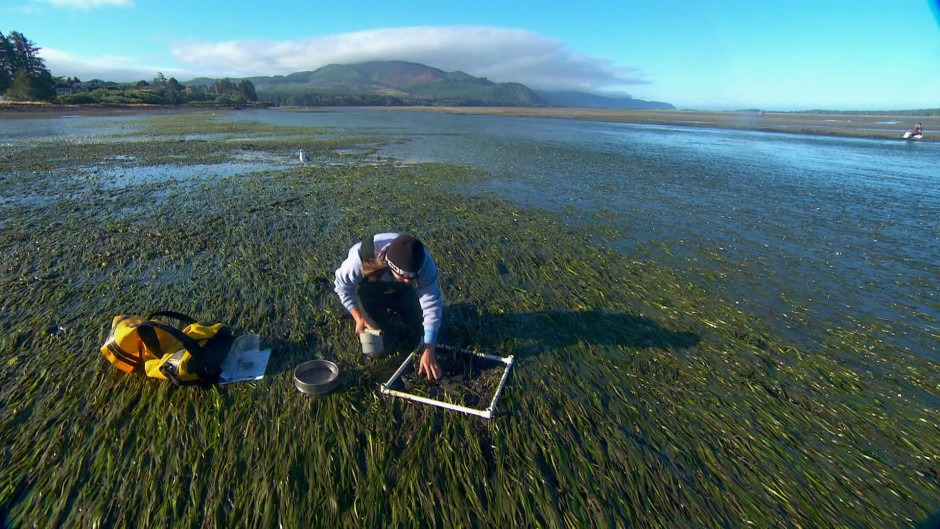
Can Kelp And Seagrass Help The Northwest Adapt To Ocean Change?
Listen
Brian Allen is up to his elbows in cold, black water. He’s hanging over the side of a small boat, trying to pull in a tangle of ropes.
They’re heavy and being dragged sideways by the current. He strains against them.
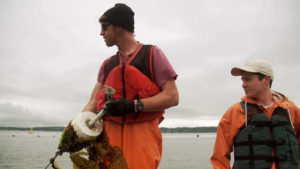
Brian Allen (left) and Ryan Cox of the Puget Sound Restoration Fund pull kelp lines on Hood Canal. CREDIT: GREG DAVIS
Allen is a researcher with the Puget Sound Restoration Fund. He’s working within a 2.5 acre plot of open water near the mouth of Hood Canal, west of Seattle. The area is roped off on two ends, and inside dozens of buoys bob in the low chop.
Below the surface, there are 60-foot grow lines covered in yellow sugar kelp.
Allen untangles a line and hooks it onto a manual winch at the back of the boat. He starts cranking the kelp to the surface.
“Here’s good looking plant,” he says, grabbing one of the 6 foot blades of kelp. “I use the term plant loosely, they are not plants. They’re protists related to slime molds and amoebas.
But like trees, bushes and other plants, kelp makes energy through photosynthesis: carbon dioxide in, oxygen out.
And this exchange of gasses is what scientists are trying to understand and harness in an effort to adapt to a major and troubling shift in ocean chemistry happening around the world.
Ya Got Trouble
The world’s oceans are giant carbon sponges. They suck up about a quarter of the carbon dioxide we pump into the air. And for the past century, people have been pumping CO2 into the atmosphere at unprecedented rates.
On land, the carbon is causing climate change. But in the ocean, it’s changing ocean chemistry – causing seawater to become more acidic.
That’s no good for all kinds of sea life, especially those with shells.
The oceans off Oregon and Washington are ground zero for ocean acidification, and Northwest scientists have been at the forefront of a new line of research. They’re testing whether marine plants can help shellfish, and the more than $200 million industry built around them, cope with these changes.
Betsy Peabody of Puget Sound Restoration Fund helped organize the research on Hood Canal. Federal, state and university researchers are running tests at the kelp farm. They’re looking at changes in pH, how much carbon is being taken out of the water, and how tiny marine snails called pteropods (important creatures at the bottom of the ocean food chain) are responding.
There’s also potential practical applications because being surrounded by low-carbon seawater makes it easier for shellfish to grow.
“You could create, in theory, a kind of seaweed filter, you know curtain, around where you’re growing shellfish. So that as water is circulating through that system, seaweed is pulling CO2 out of that water,” Peabody says.
The kelp project is happening in part because Washington state prioritized this kind of ocean acidification researchback in 2012. Oregon’s committee appointed to work on the issue met for the first time this year and have yet to set priorities.
But researchers in the state are already looking at another marine plant that’s showing promise.
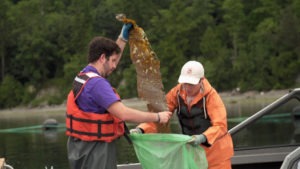
Stephen Schreck (left) and Ryan Cox of Puget Sound Restoration Fund collect kelp samples. CREDIT: GREG DAVIS
Probing the Shallows
Oregon State University scientist Caitlin Magel sifts through a muddy clump of leaves and roots in the shallow water of a tide flat in Netarts Bay on Oregon’s North Coast. She’s surrounded by a long, thin bed of sea grass.
“It’s the native eelgrass to the Pacific Northwest,” she says of the bright green grass, lying flat on the mud at low tide.
The seagrass uses photosynthesis like kelp. But unlike sugar kelp it persists from year to year and also has roots.
“They have this below-ground carbon storage that can lead to long-term sequestration of carbon,” she says.
Magel is trying to get a handle on just how much carbon these shallow eelgrass beds are pulling out of the water. She’s taking samples from several bays along Oregon and Washington to see how this differs in each location.
Other scientists are seeing reductions in ocean acidification immediately around seagrass beds, especially during the day when the plants are activing using photosynthesis to grow.
“It could be grown in and amongst, for instance, an oyster aquaculture bed,” Magel says. “Or in the case of a shellfish hatchery, they could pinpoint where they’re drawing their water, so that they’re drawing from within an eel grass bed.”
There is still a lot that is unknown about the potential of kelp and sea grass to provide relief for ocean acidification. There’s healthy skepticism that marine plants can make a difference on a broad scale, because the ocean is huge and plants mainly grow in coastal areas. And like terrestrial forests, there’s no way kelp and eel grass can keep up with the rate of human carbon emissions.
But the target of much of this early science in the Northwest is shellfish production. And by focusing on smaller-scale benefits, the research is creating a path coastal communities can follow to adapt to the changes that are happening outside their doors.
Copyright 2018 Earthfix
Related Stories:

Pacific Northwest author’s new novel captures atmosphere of the region
On a gray, early spring morning, I drove to Steilacoom, Washington, to catch the ferry to Anderson Island. I boarded alongside the line of other cars and after parking, stepped out onto the deck of the boat. The ferry pushed off from the dock and rocked a little in the Puget Sound before steadying.
I took this journey to the real Anderson Island to see from the water what inspired Northwest author Kirsten Sundberg Lunstrum’s new novel, “Elita,” which was published earlier this year. Sundberg Lunstrum was inspired while sailing around the Puget Sound to write a mystery novel on an island.
Sundberg Lunstrum read excerpts of the book at a gathering at Tacoma’s Grit City Books.
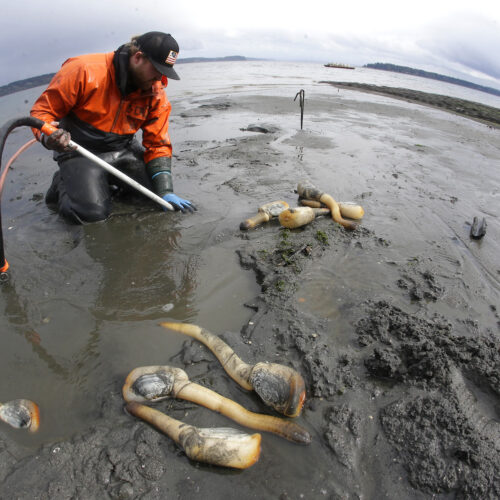
Shellfish harvesters are having to consider biotoxins later into fall and winter
It used to be the case that people who harvest shellfish could breathe a sigh of relief in late autumn. Spring, summer and even early fall have long presented the right conditions for harmful algae to grow and produce biotoxins in waters along the Washington state coast and into Puget Sound.
But in recent years, recreational and commercial harvesters, state agencies and tribes are noticing biotoxin outbreaks more commonly in the winter, too.
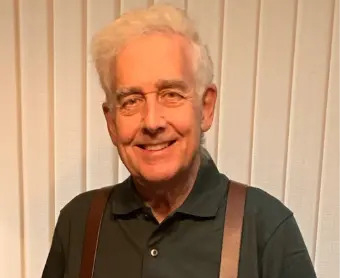
Remembering a South Sound radio icon
John Mangan ran I-91, KVTI for nearly 30 years. (Credit: Kevin Mangan) Listen (Runtime 4:01) Read In the spring, the South Sound lost an airwaves icon. John Mangan ran the














